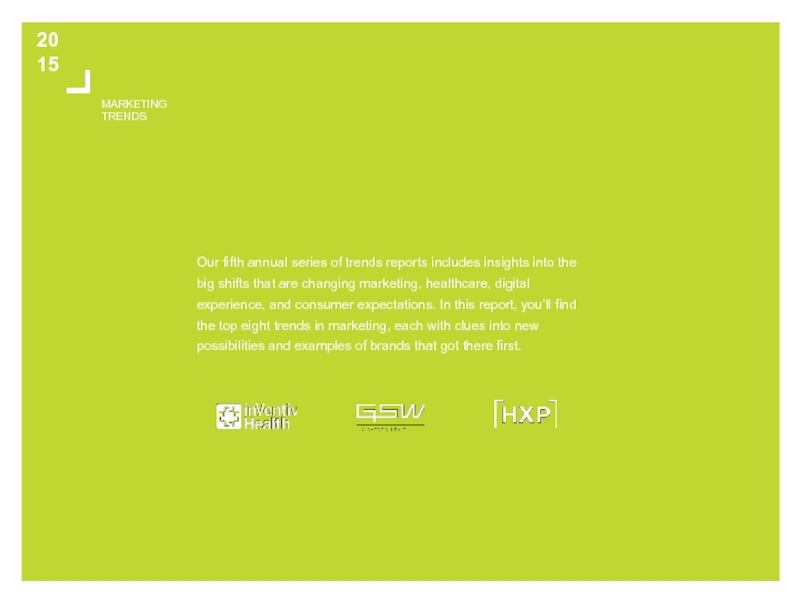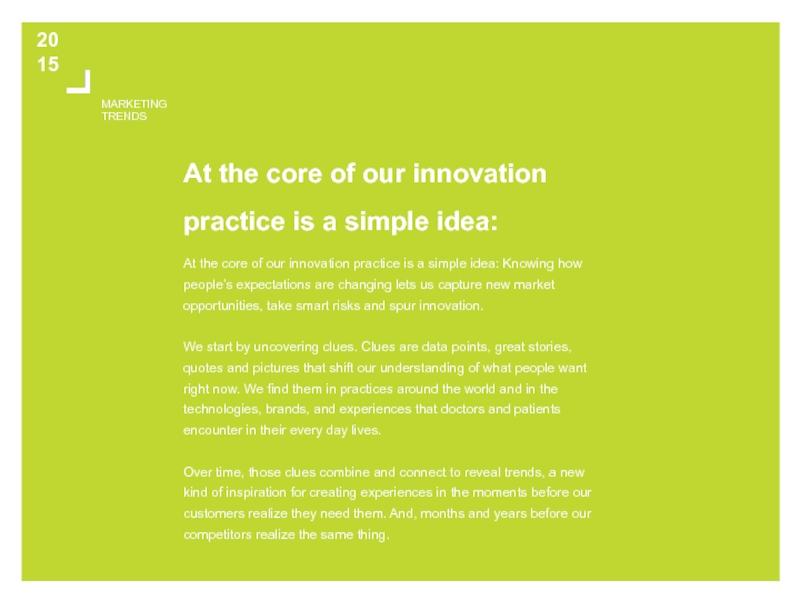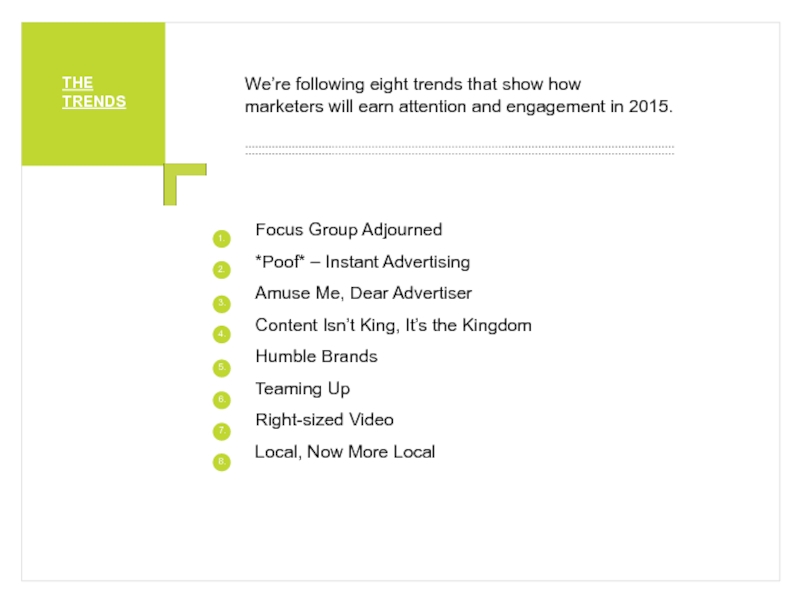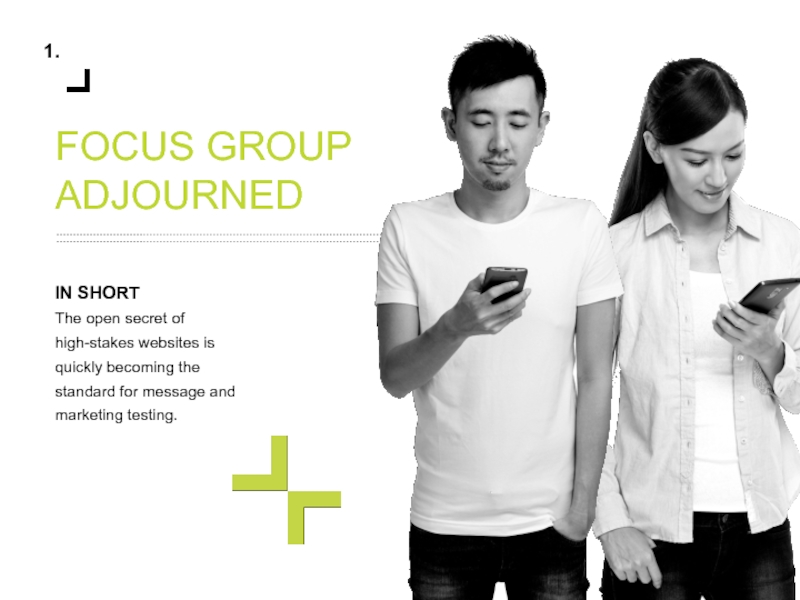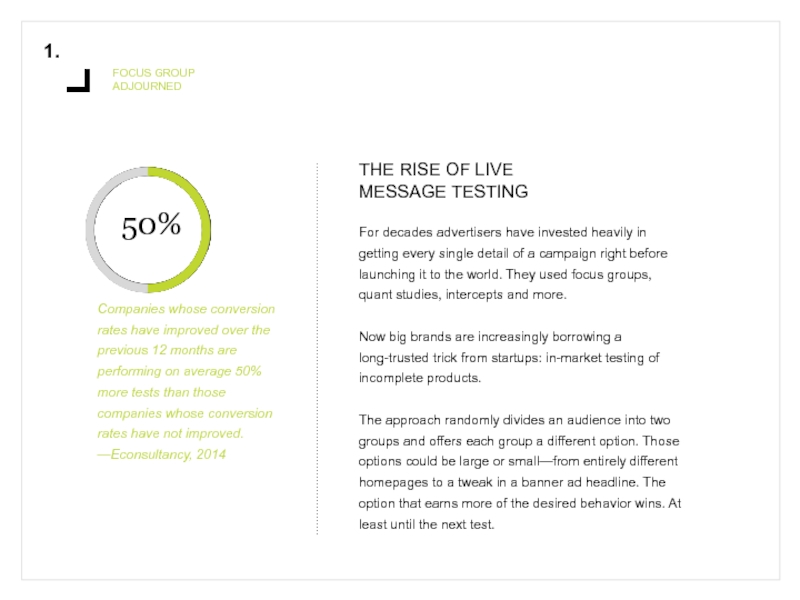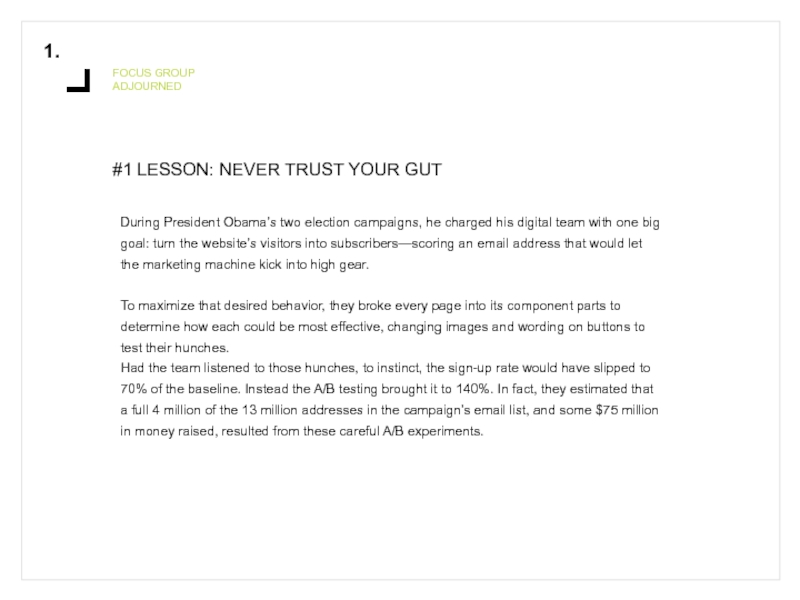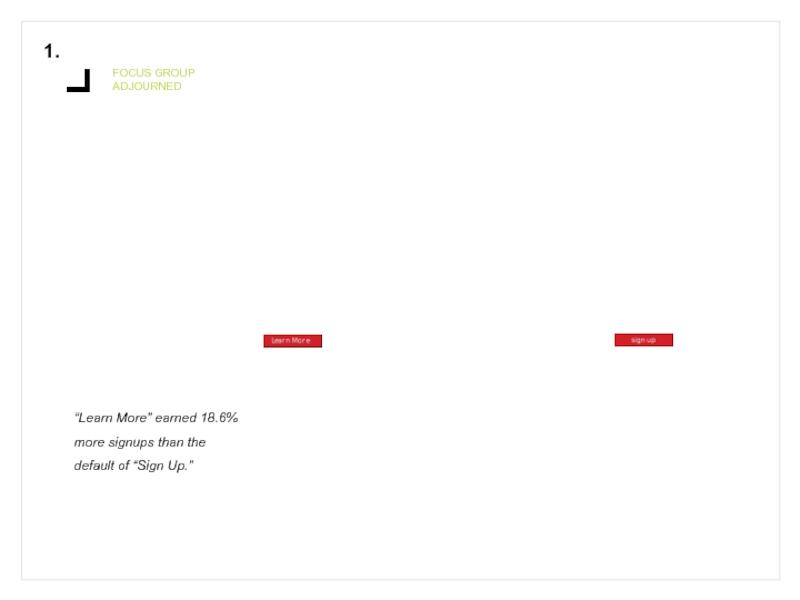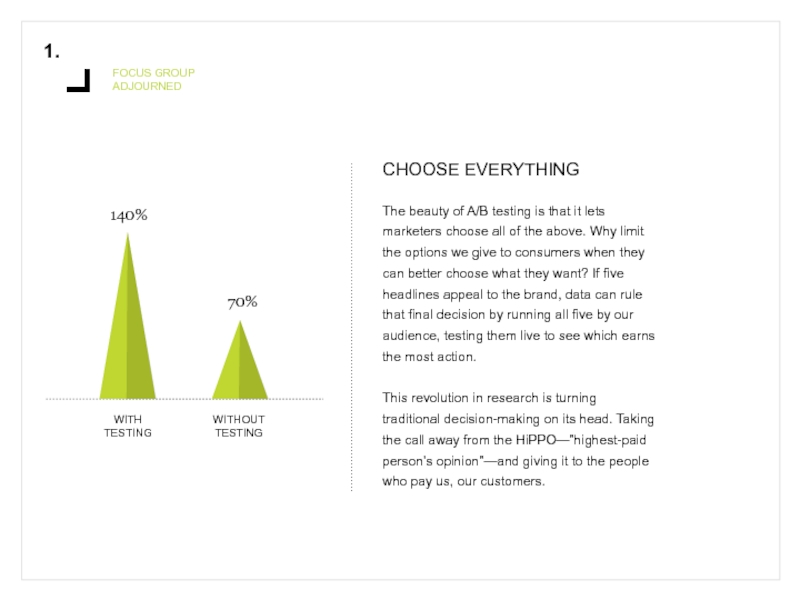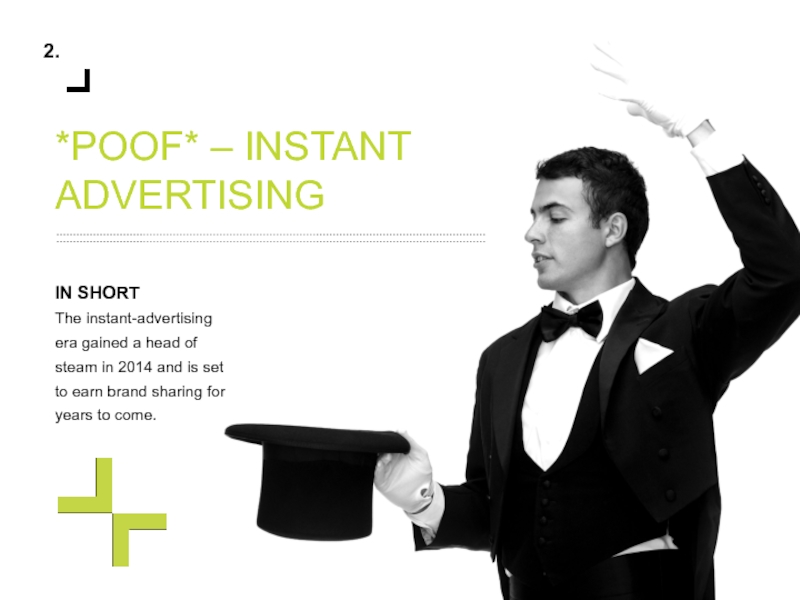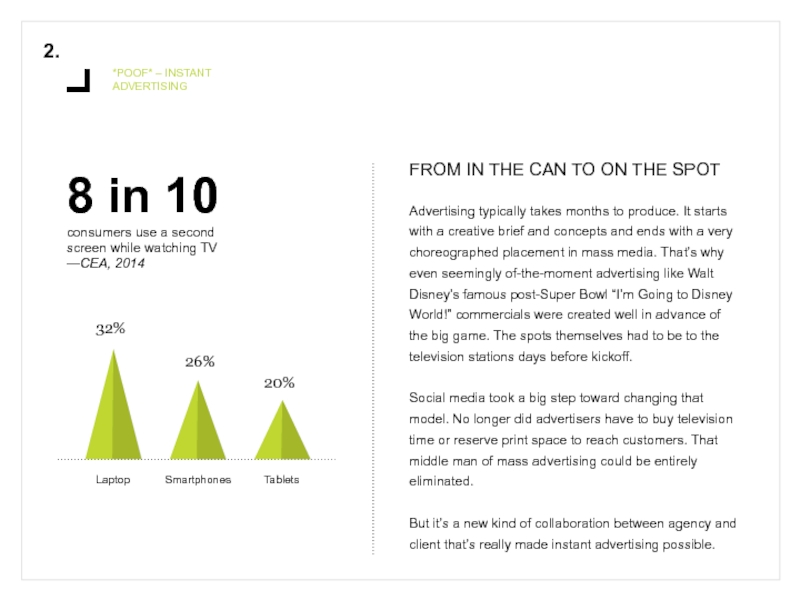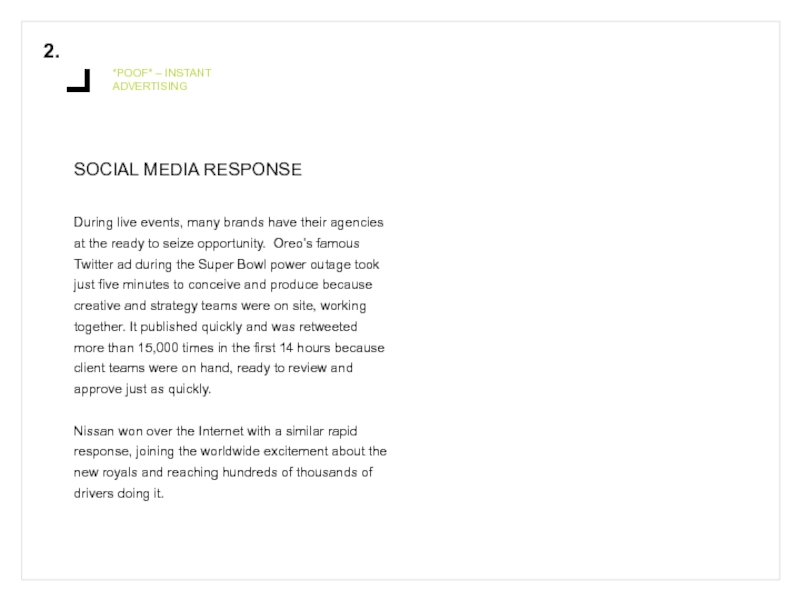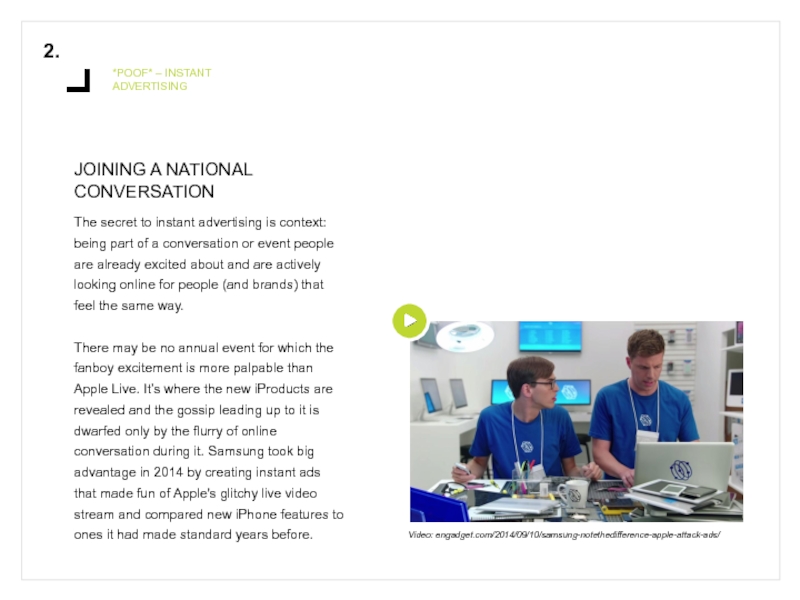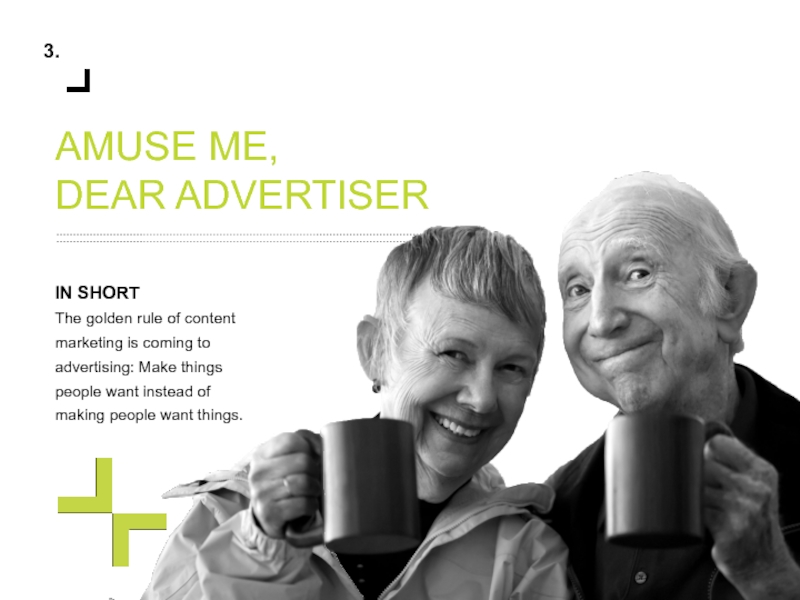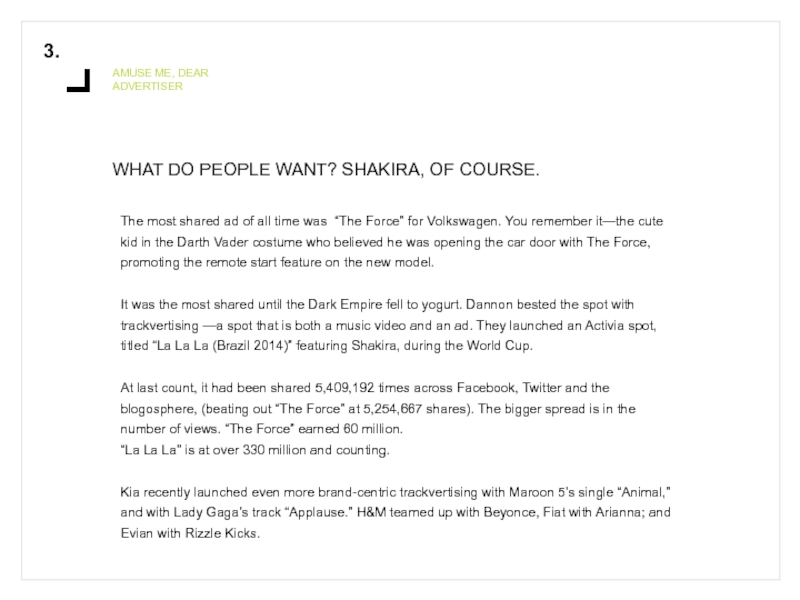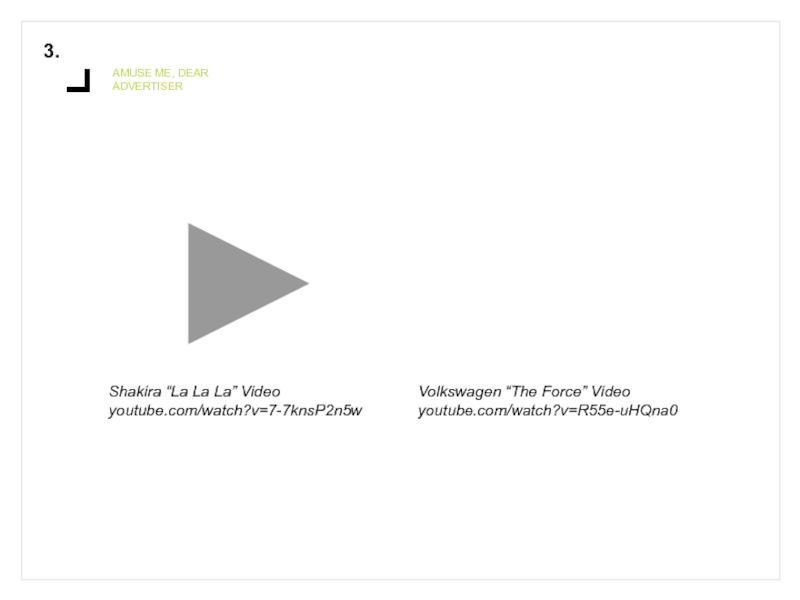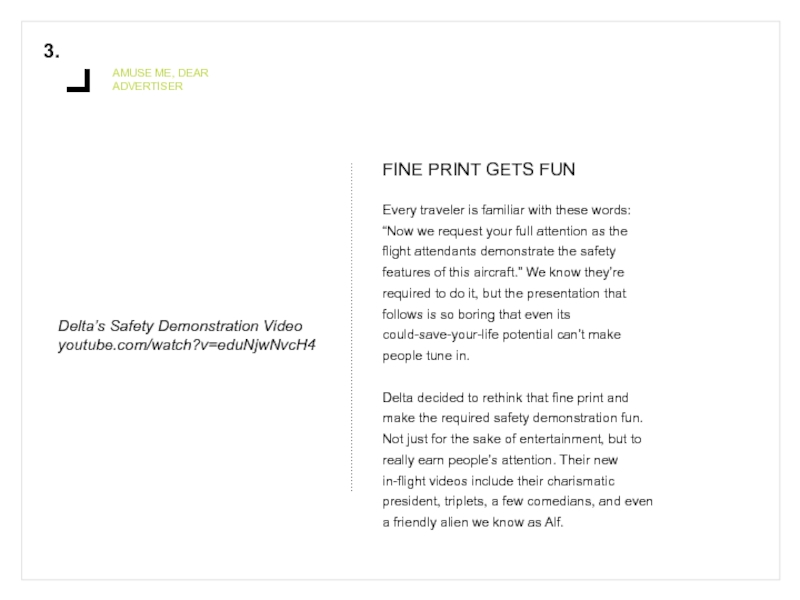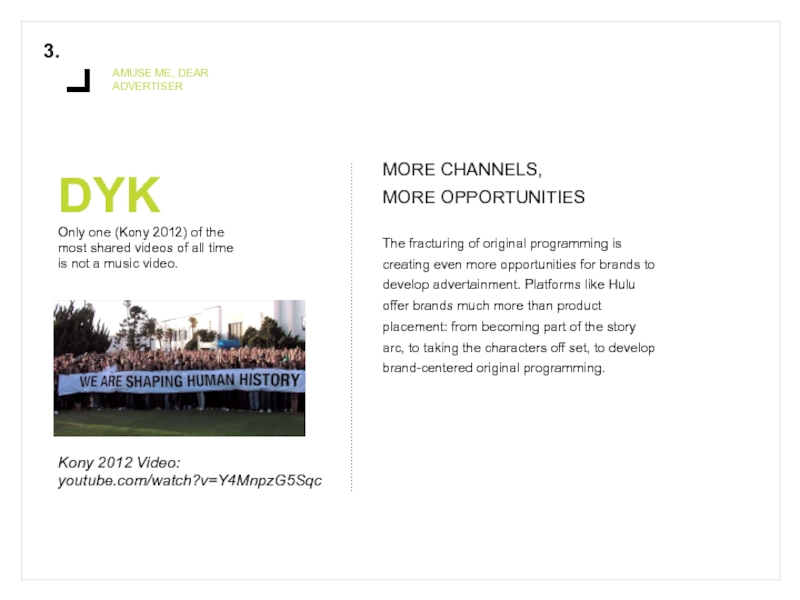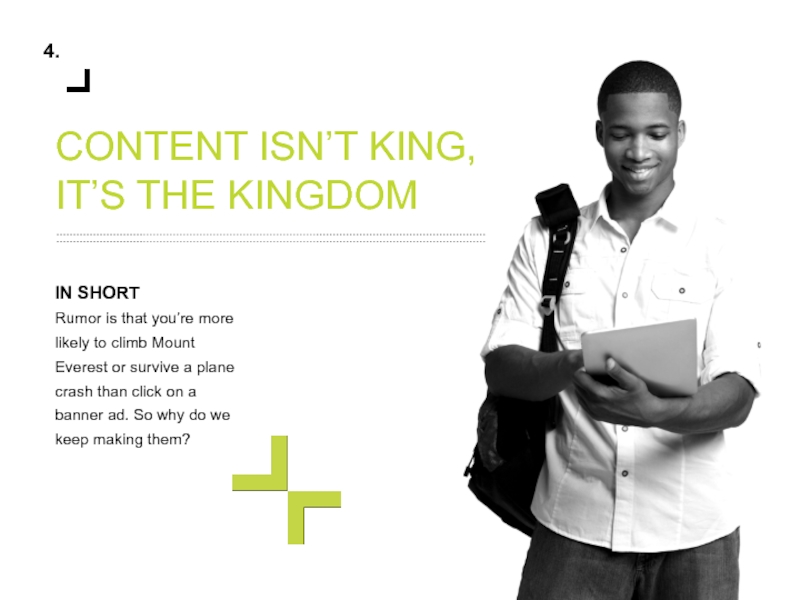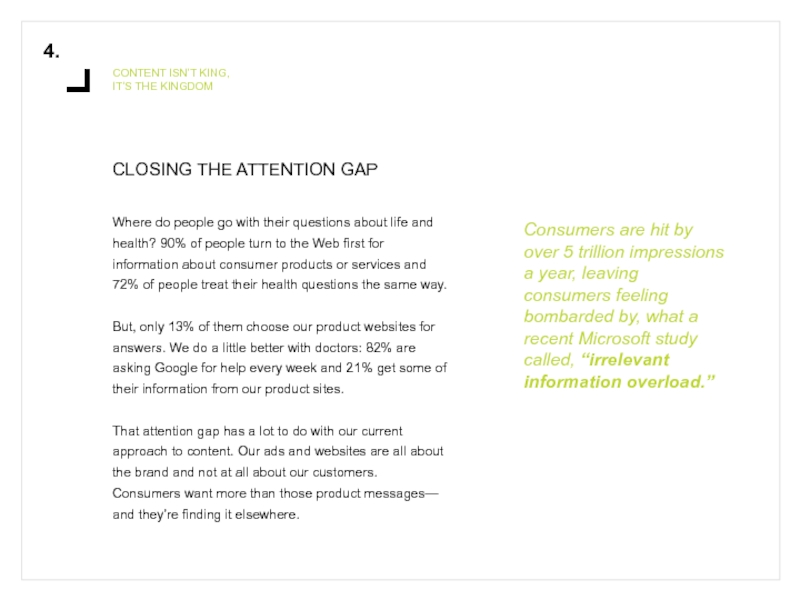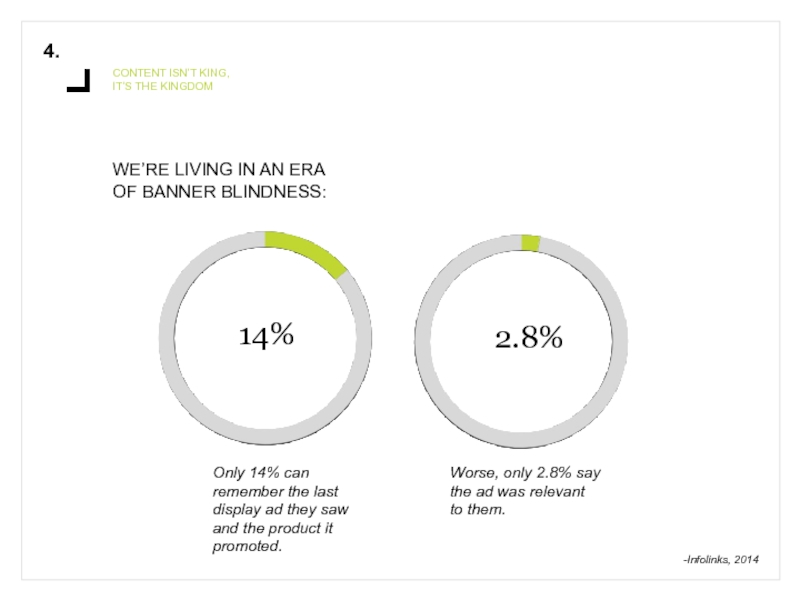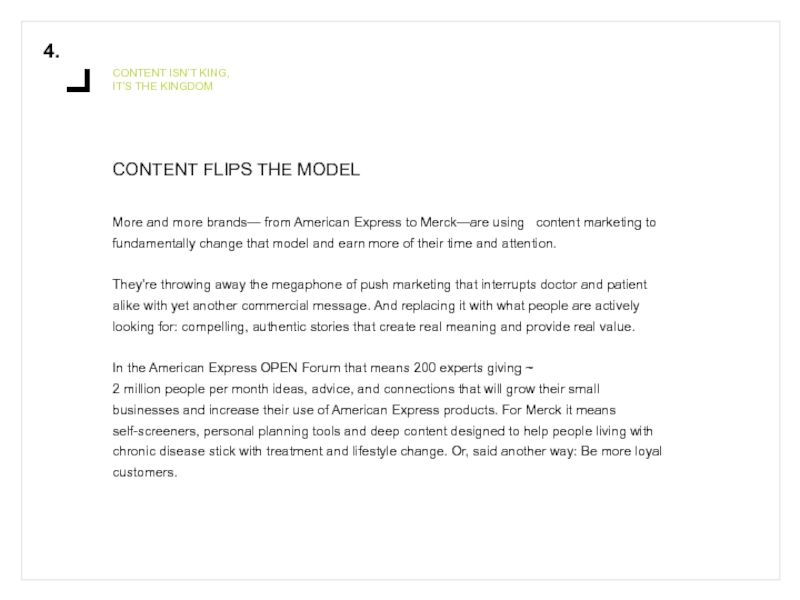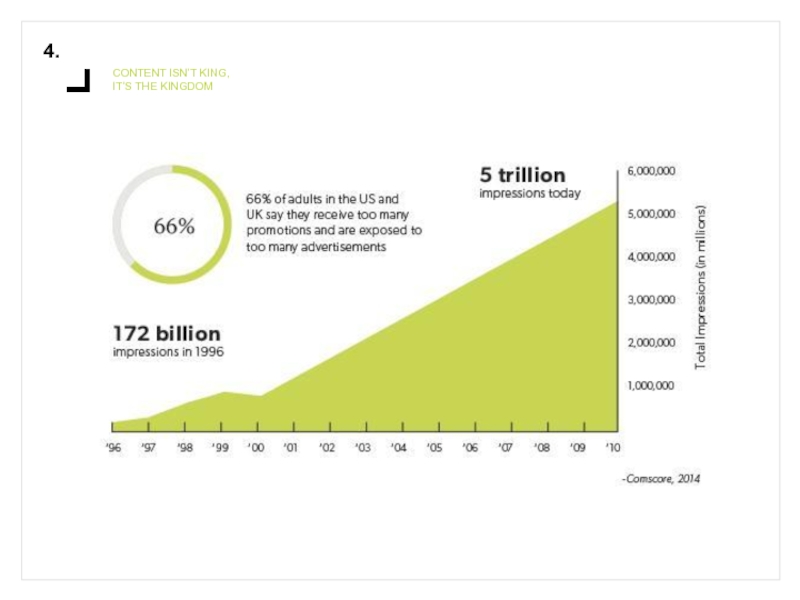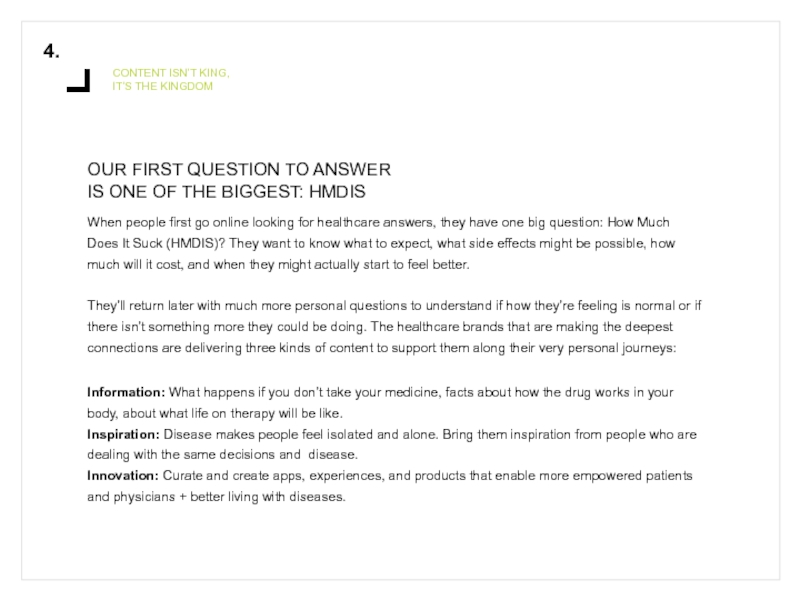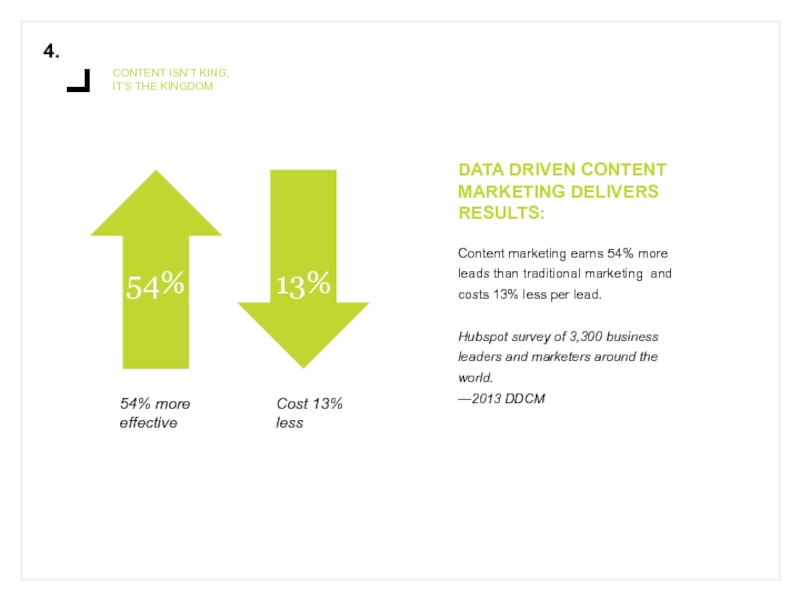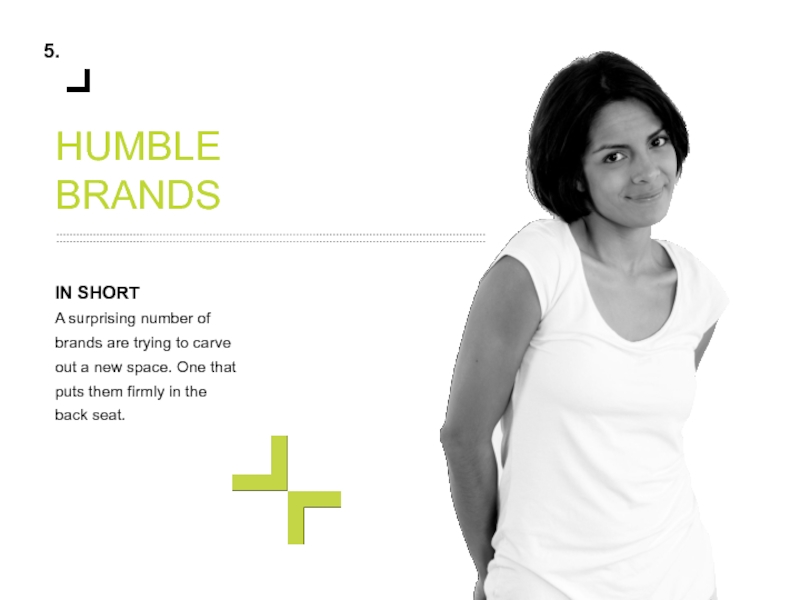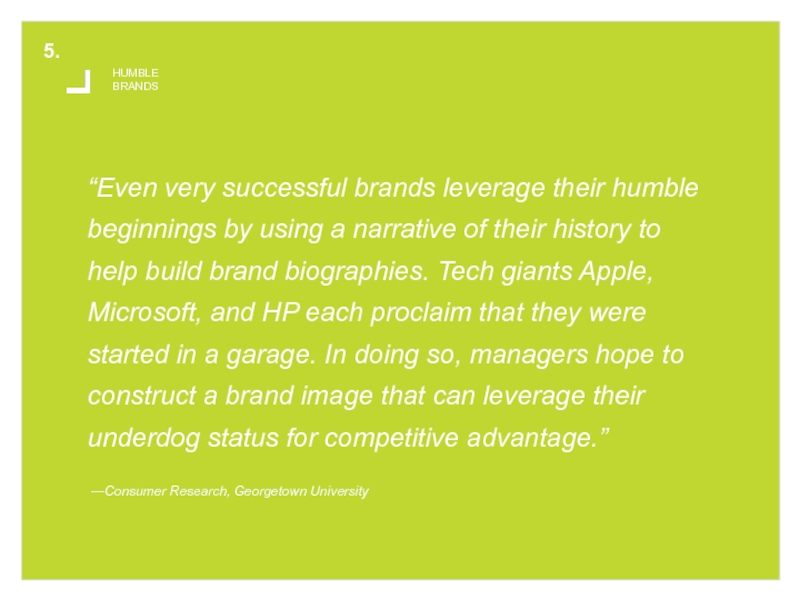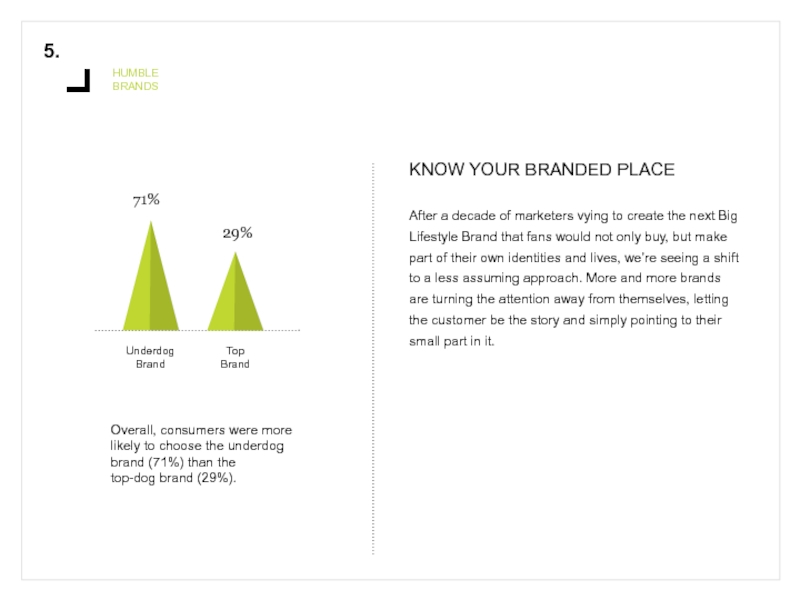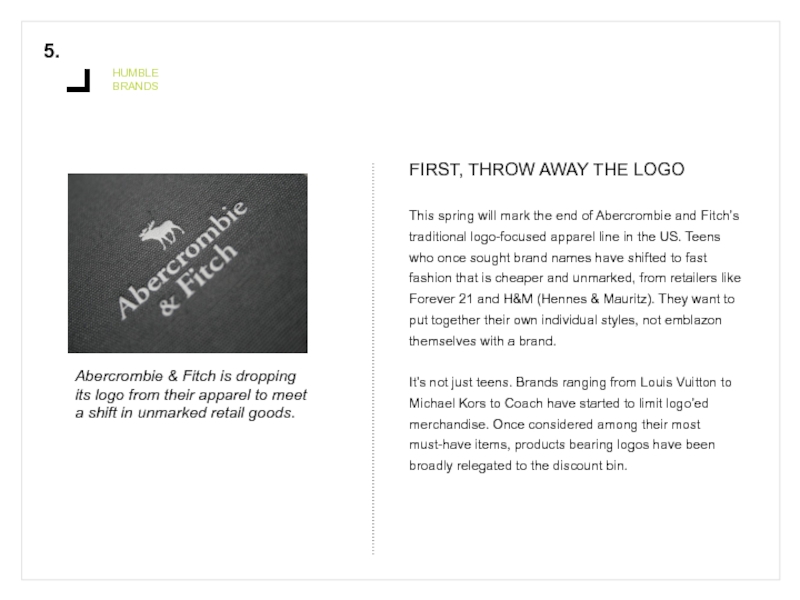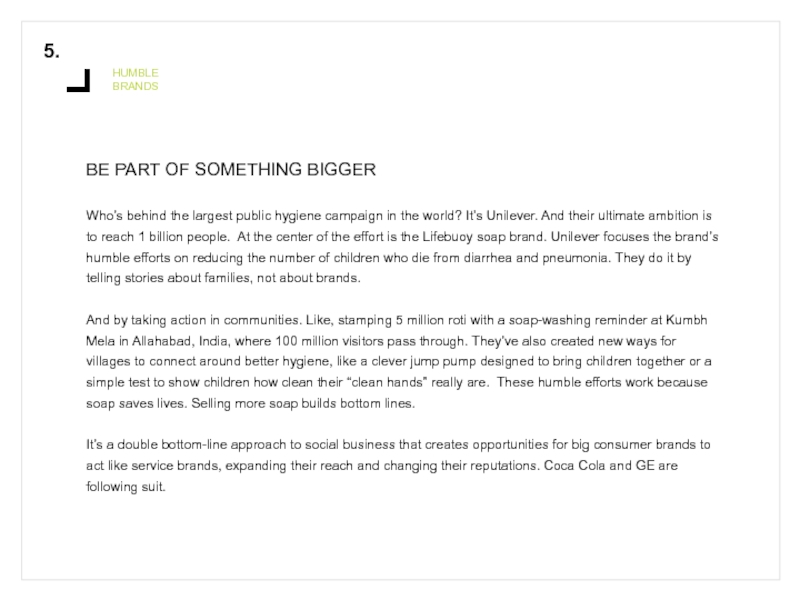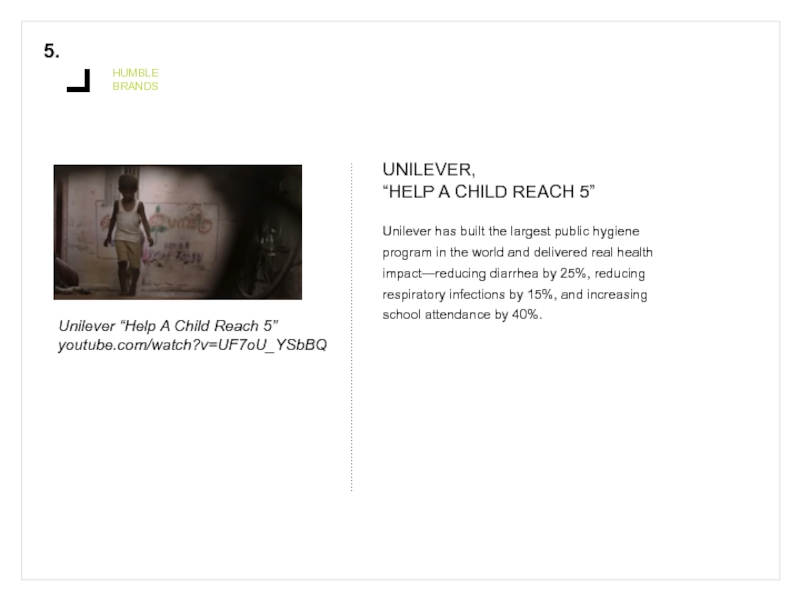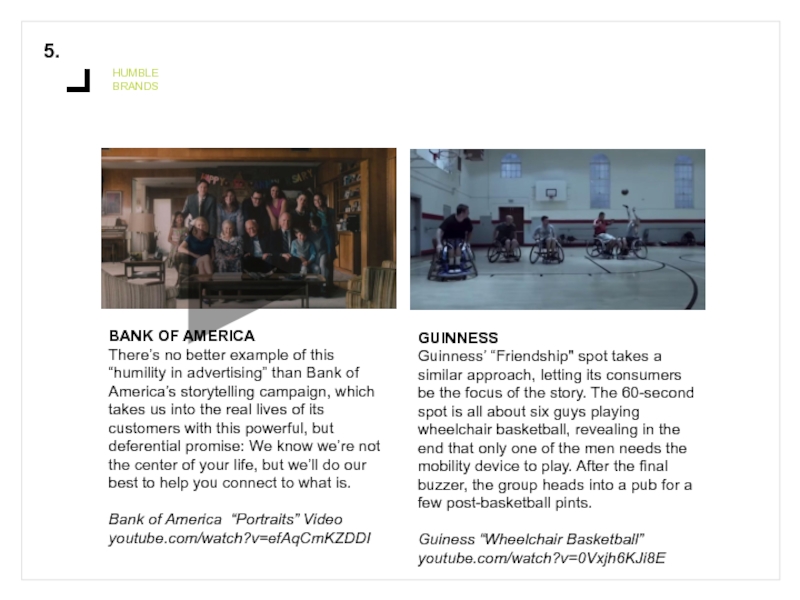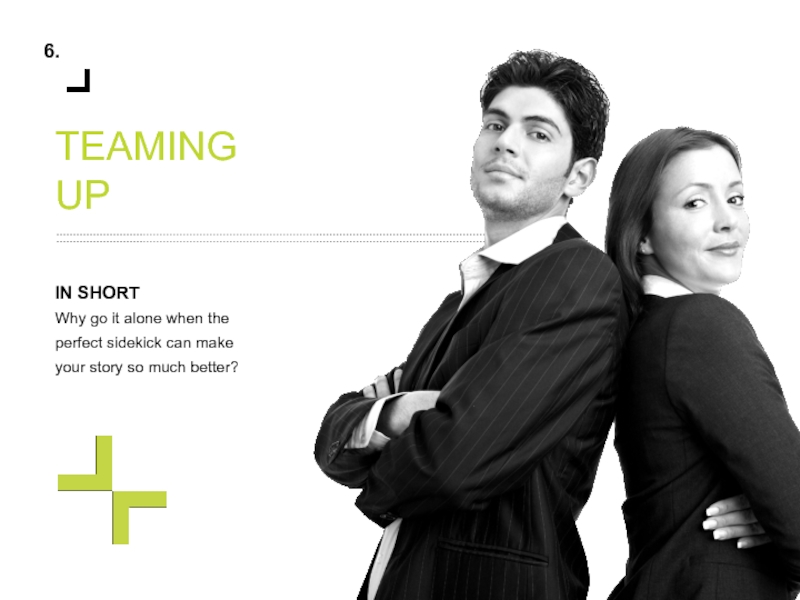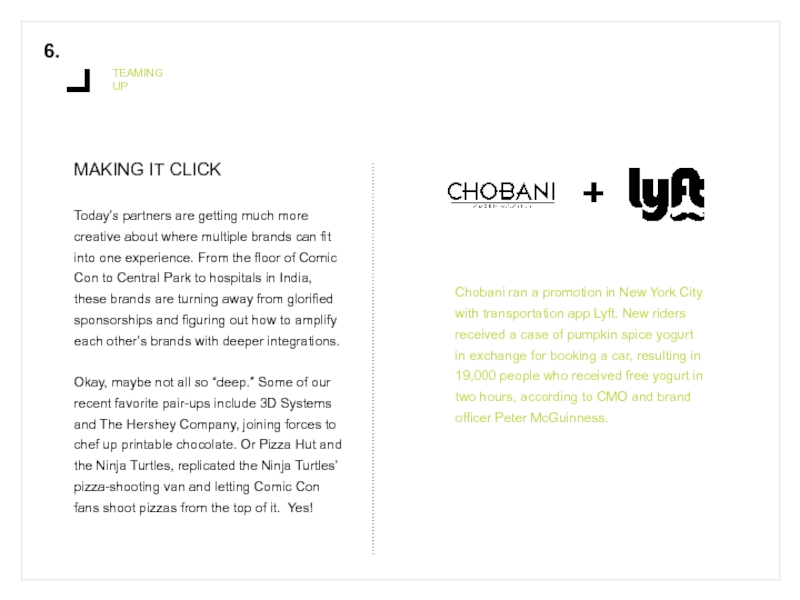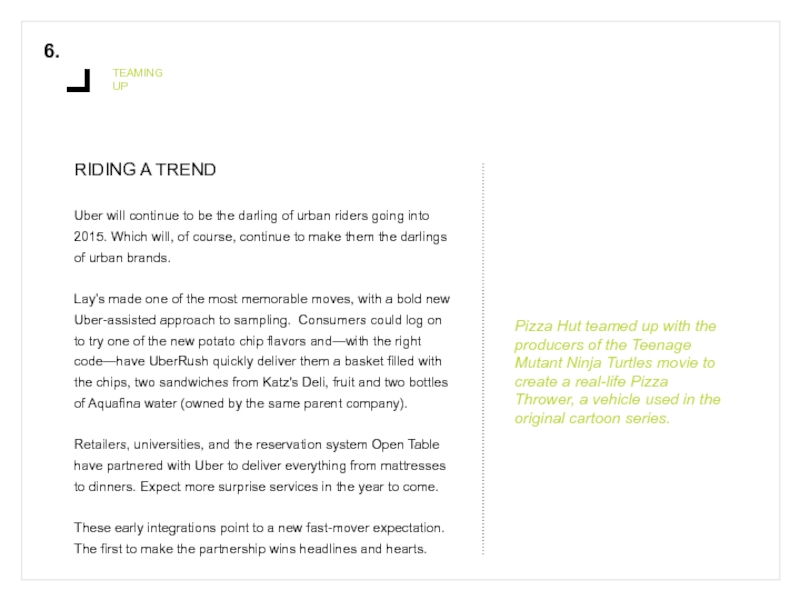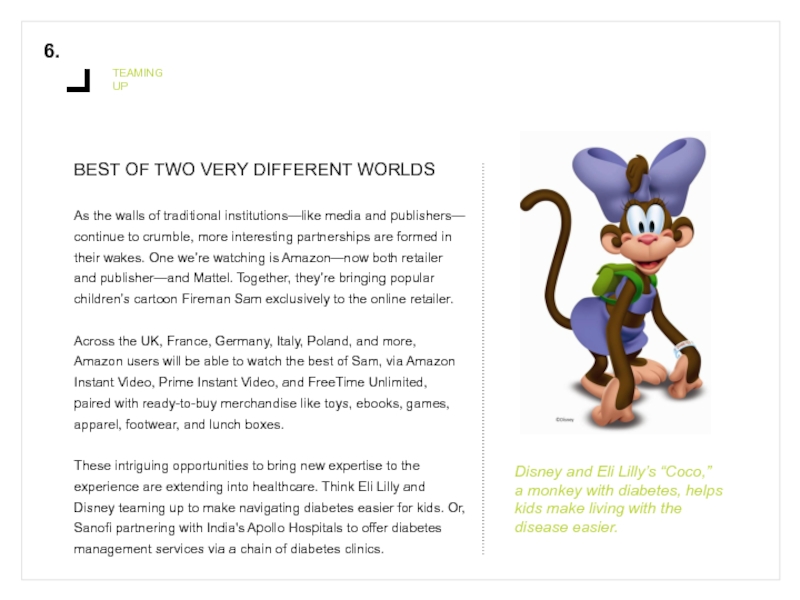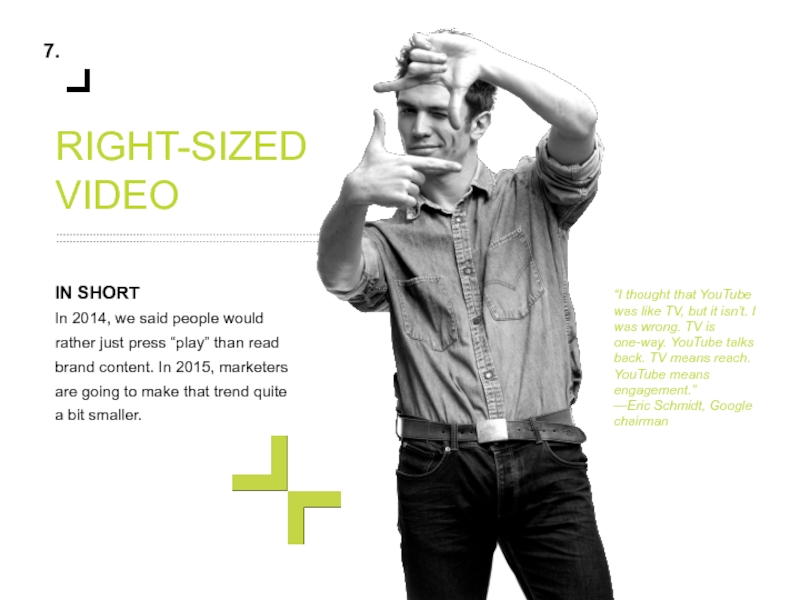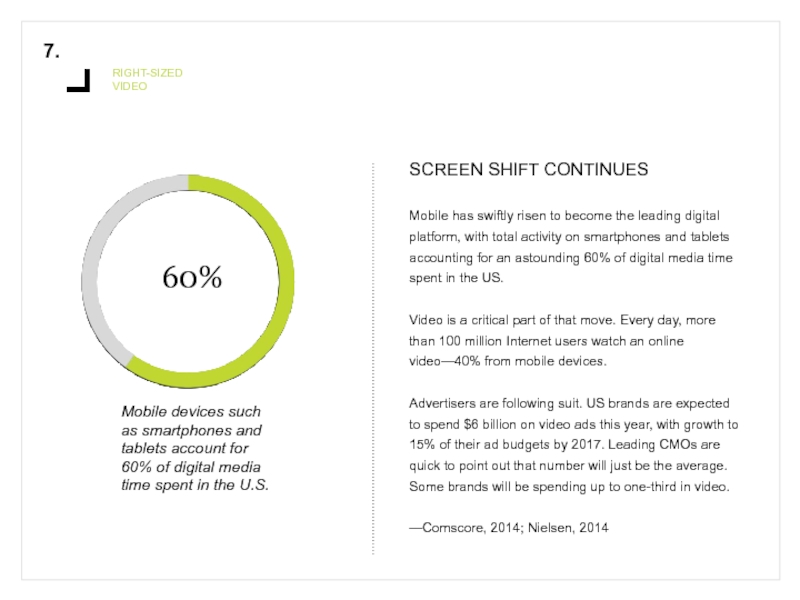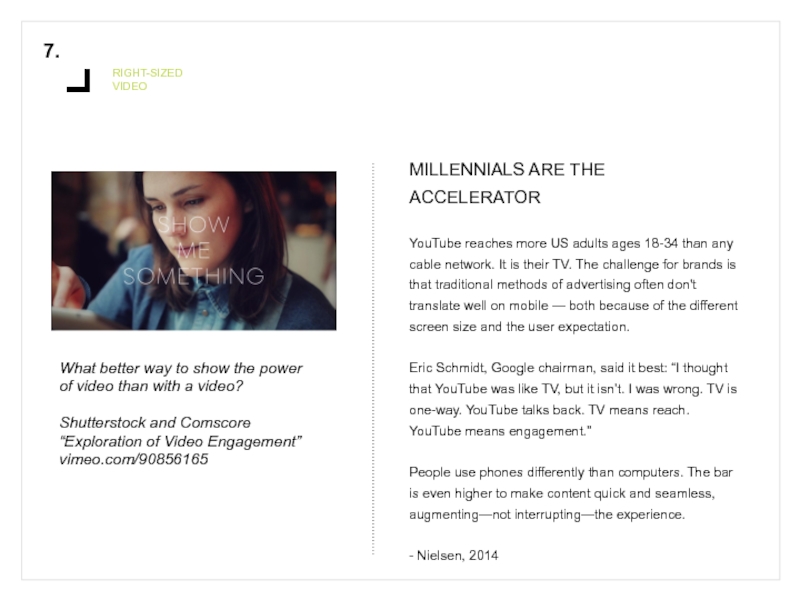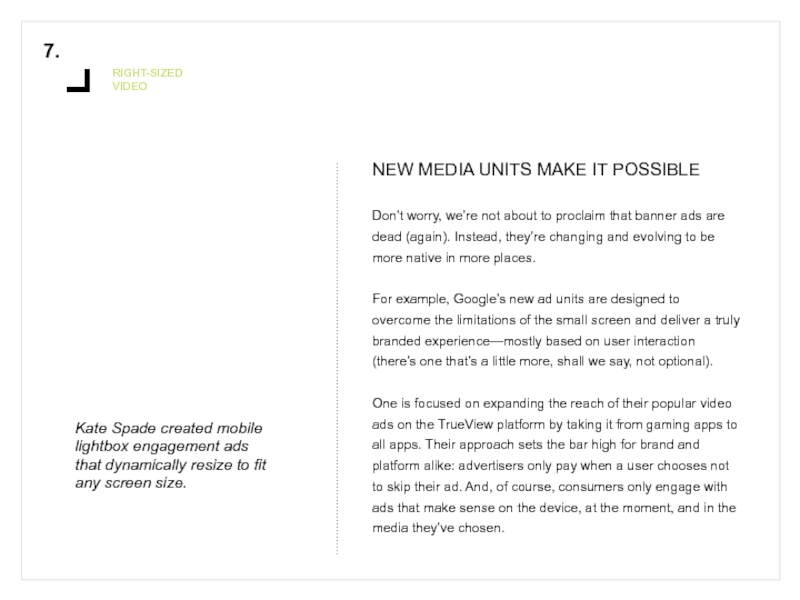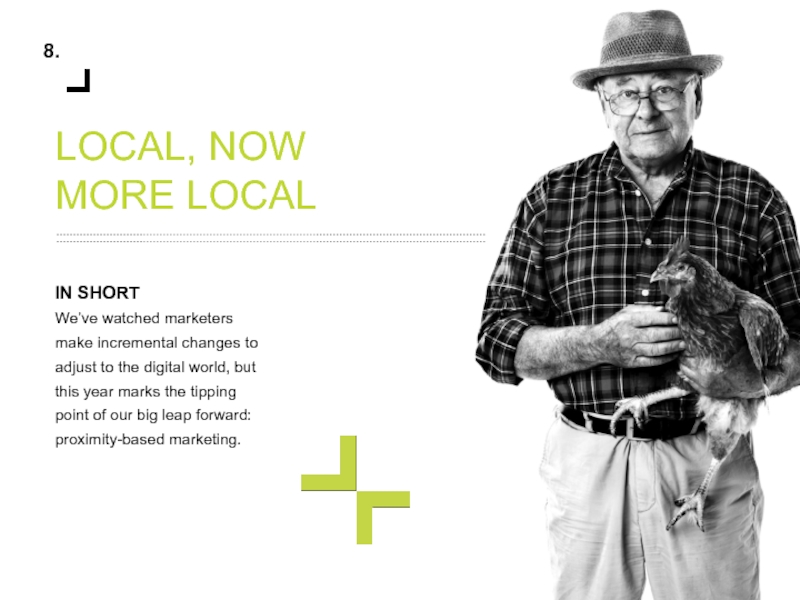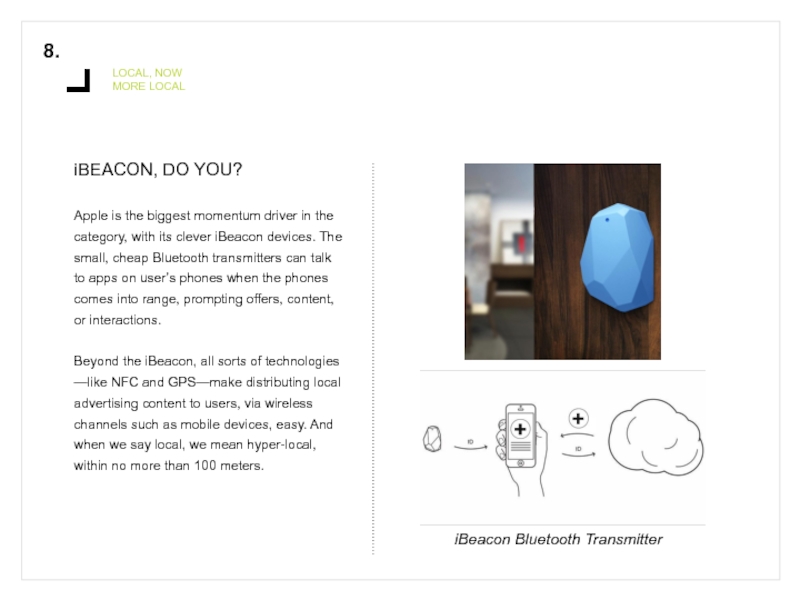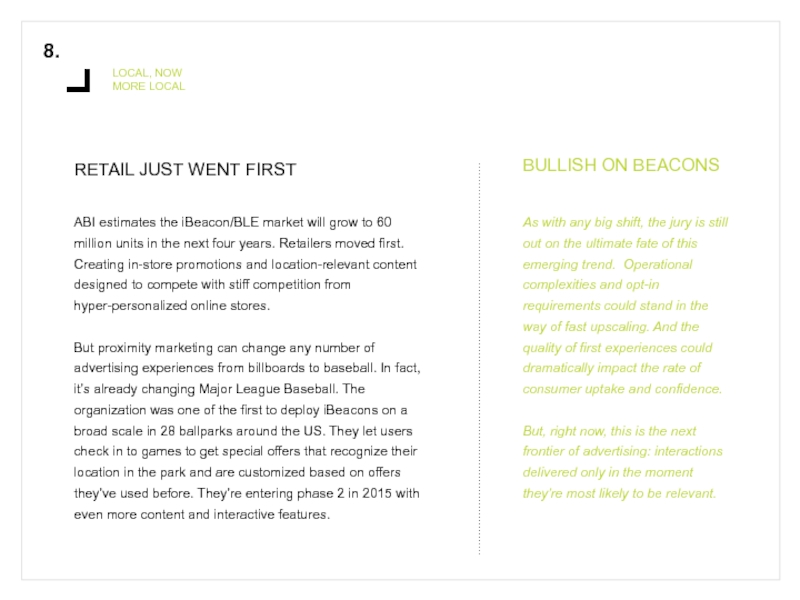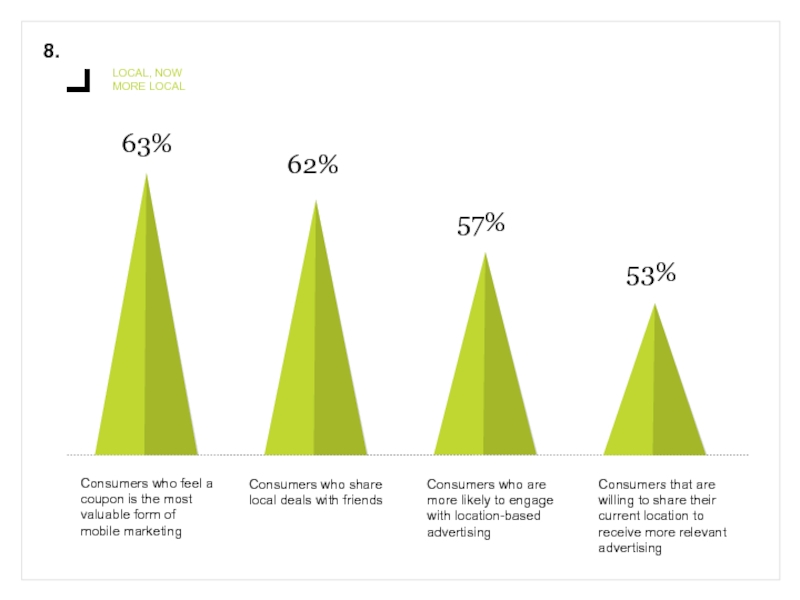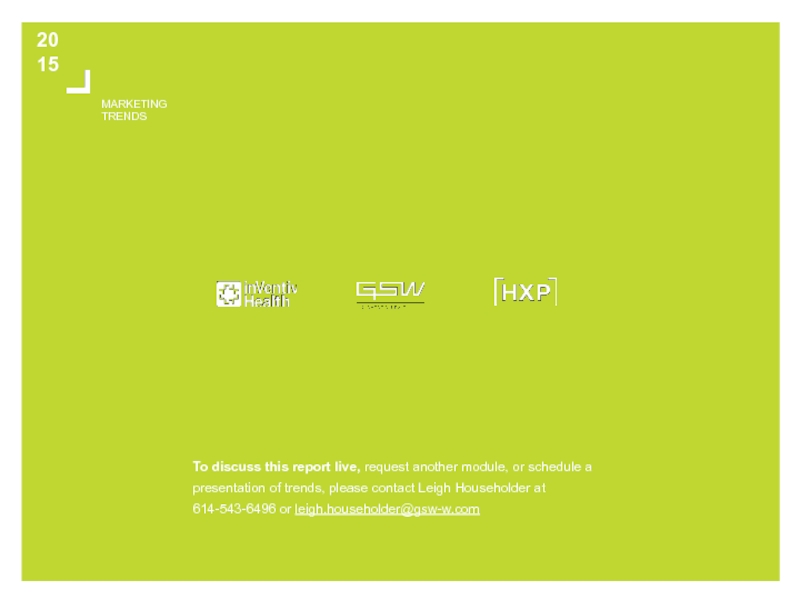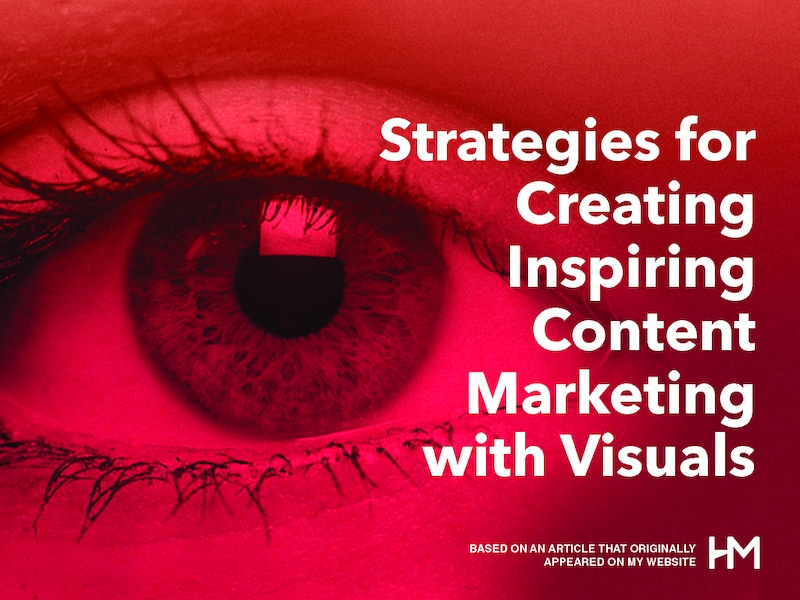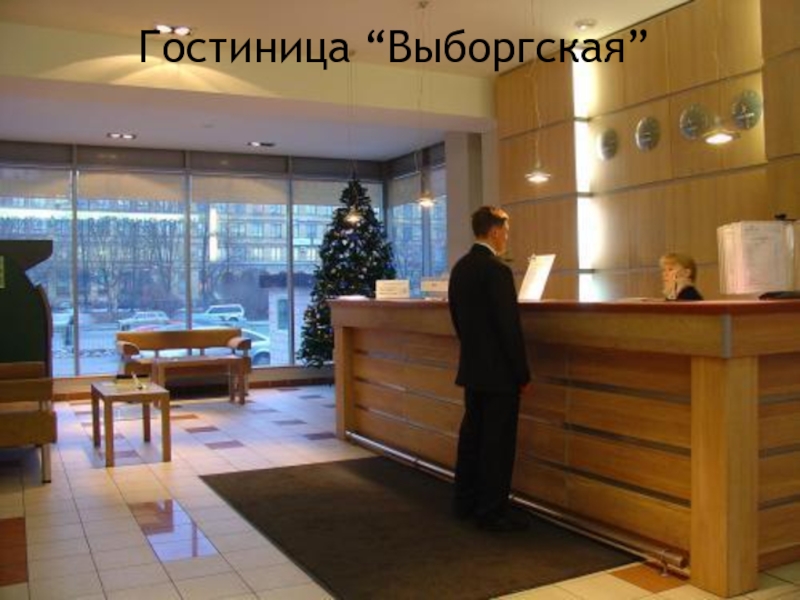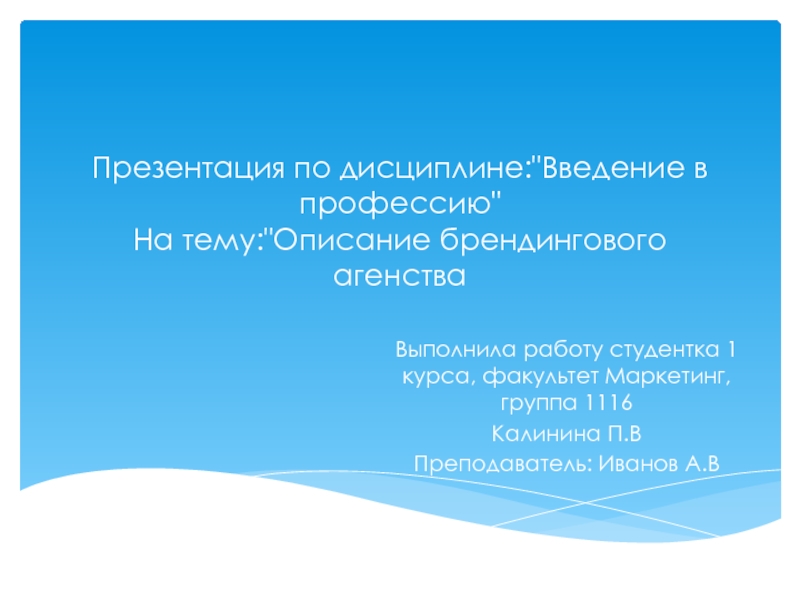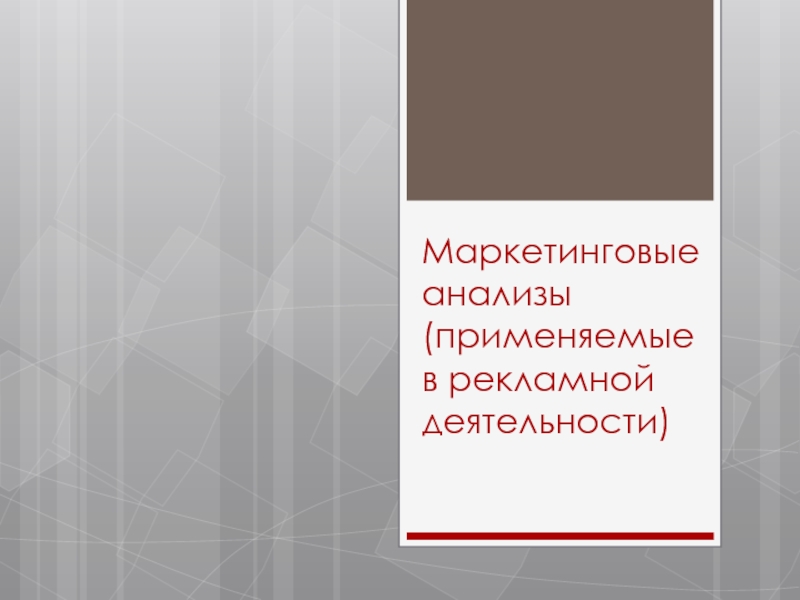- Главная
- Разное
- Дизайн
- Бизнес и предпринимательство
- Аналитика
- Образование
- Развлечения
- Красота и здоровье
- Финансы
- Государство
- Путешествия
- Спорт
- Недвижимость
- Армия
- Графика
- Культурология
- Еда и кулинария
- Лингвистика
- Английский язык
- Астрономия
- Алгебра
- Биология
- География
- Детские презентации
- Информатика
- История
- Литература
- Маркетинг
- Математика
- Медицина
- Менеджмент
- Музыка
- МХК
- Немецкий язык
- ОБЖ
- Обществознание
- Окружающий мир
- Педагогика
- Русский язык
- Технология
- Физика
- Философия
- Химия
- Шаблоны, картинки для презентаций
- Экология
- Экономика
- Юриспруденция
MAR KET ING презентация
Содержание
- 1. MAR KET ING
- 2. 20 15 MARKETING TRENDS Our fifth
- 3. 20 15 MARKETING TRENDS Abigail Schmelzer
- 4. At the core of our innovation
- 5. Focus Group Adjourned *Poof* – Instant
- 6. FOCUS GROUP ADJOURNED 1. IN SHORT The
- 7. THE RISE OF LIVE MESSAGE TESTING
- 8. #1 LESSON: NEVER TRUST YOUR GUT
- 9. 1. FOCUS GROUP ADJOURNED “Learn More”
- 10. CHOOSE EVERYTHING The beauty of A/B
- 11. *POOF* – INSTANT ADVERTISING 2. IN SHORT
- 12. FROM IN THE CAN TO ON THE
- 13. SOCIAL MEDIA RESPONSE 2. *POOF* –
- 14. JOINING A NATIONAL CONVERSATION 2. *POOF*
- 15. AMUSE ME, DEAR ADVERTISER 3. IN
- 16. WHAT DO PEOPLE WANT? SHAKIRA, OF COURSE.
- 17. 3. AMUSE ME, DEAR ADVERTISER Shakira
- 18. FINE PRINT GETS FUN Every traveler
- 19. MORE CHANNELS,
- 20. CONTENT ISN’T KING, IT’S THE KINGDOM
- 21. CLOSING THE ATTENTION GAP 4. CONTENT
- 22. 4. CONTENT ISN’T KING, IT’S
- 23. CONTENT FLIPS THE MODEL 4. CONTENT
- 24. 4. CONTENT ISN’T KING, IT’S THE KINGDOM
- 25. OUR FIRST QUESTION TO ANSWER IS ONE
- 26. 4. CONTENT ISN’T KING, IT’S
- 27. HUMBLE BRANDS 5. IN SHORT A surprising
- 28. 5. HUMBLE BRANDS “Even very successful
- 29. KNOW YOUR BRANDED PLACE After a
- 30. FIRST, THROW AWAY THE LOGO
- 31. BE PART OF SOMETHING BIGGER
- 32. UNILEVER, “HELP A CHILD REACH 5”
- 33. 5. HUMBLE BRANDS BANK OF AMERICA
- 34. TEAMING UP 6. IN SHORT Why go
- 35. MAKING IT CLICK Today’s partners are
- 36. RIDING A TREND Uber will continue
- 37. BEST OF TWO VERY DIFFERENT WORLDS
- 38. RIGHT-SIZED VIDEO 7. IN SHORT In 2014,
- 39. SCREEN SHIFT CONTINUES Mobile has swiftly
- 40. MILLENNIALS ARE THE ACCELERATOR YouTube reaches
- 41. NEW MEDIA UNITS MAKE IT POSSIBLE
- 42. LOCAL, NOW MORE LOCAL 8. IN SHORT
- 43. iBEACON, DO YOU? Apple is the
- 44. RETAIL JUST WENT FIRST 8. LOCAL,
- 45. 8. LOCAL, NOW MORE LOCAL 63%
- 46. 20 15 MARKETING TRENDS To discuss
Слайд 2
20
15
MARKETING
TRENDS
Our fifth annual series of trends reports includes insights into the
Слайд 320
15
MARKETING
TRENDS
Abigail Schmelzer
Alex Brock
Andrea Evans
Angela Cua
Azul Ceballos
Campbell Hooper
Charles DiSantis
Chelsea Bailey
Duncan Arbour
Eduardo Menendez
Eric
Fred Harrison
James Tomasino
Jeffrey Giermek
Jessie Brown
Joe DeSalvo
John Mucha
Joy Hart
Julie Valka
Kathryn Bernish-Fisher
Kevin Nalty
Leigh Householder
Luke Hebblethwaite
Matt Groom
Mike Martins
Nick Bartlett
Nicole Sordell
Pavithra Selvam
Phil Storer
Richard Martin
Rick Summa
Sam Cannizzaro
Sarah Brown
Sayeed Anwar
Scott Raidel
Stefanie Jones
Zach Gerber
CORE
CONTRIBUTORS
Слайд 4
At the core of our innovation practice is a simple idea:
At the core of our innovation practice is a simple idea: Knowing how people’s expectations are changing lets us capture new market opportunities, take smart risks and spur innovation.
We start by uncovering clues. Clues are data points, great stories, quotes and pictures that shift our understanding of what people want right now. We find them in practices around the world and in the technologies, brands, and experiences that doctors and patients encounter in their every day lives.
Over time, those clues combine and connect to reveal trends, a new kind of inspiration for creating experiences in the moments before our customers realize they need them. And, months and years before our competitors realize the same thing.
20
15
MARKETING
TRENDS
Слайд 5
Focus Group Adjourned
*Poof* – Instant Advertising
Amuse Me, Dear Advertiser
Content Isn’t King,
Humble Brands
Teaming Up
Right-sized Video
Local, Now More Local
We’re following eight trends that show how
marketers will earn attention and engagement in 2015.
THE
TRENDS
1.
2.
3.
4.
5.
6.
7.
8.
Слайд 6FOCUS GROUP
ADJOURNED
1.
IN SHORT
The open secret of
high-stakes websites is quickly becoming
Слайд 7THE RISE OF LIVE
MESSAGE TESTING
For decades advertisers have invested heavily
Now big brands are increasingly borrowing a long-trusted trick from startups: in-market testing of incomplete products.
The approach randomly divides an audience into two groups and offers each group a different option. Those options could be large or small—from entirely different homepages to a tweak in a banner ad headline. The option that earns more of the desired behavior wins. At least until the next test.
Companies whose conversion rates have improved over the previous 12 months are performing on average 50% more tests than those companies whose conversion rates have not improved.
—Econsultancy, 2014
50%
1.
FOCUS GROUP
ADJOURNED
Слайд 8#1 LESSON: NEVER TRUST YOUR GUT
1.
FOCUS GROUP
ADJOURNED
During President Obama’s two election
To maximize that desired behavior, they broke every page into its component parts to determine how each could be most effective, changing images and wording on buttons to test their hunches.
Had the team listened to those hunches, to instinct, the sign-up rate would have slipped to 70% of the baseline. Instead the A/B testing brought it to 140%. In fact, they estimated that a full 4 million of the 13 million addresses in the campaign’s email list, and some $75 million in money raised, resulted from these careful A/B experiments.
Слайд 10CHOOSE EVERYTHING
The beauty of A/B testing is that it lets marketers
This revolution in research is turning traditional decision-making on its head. Taking the call away from the HiPPO—”highest-paid person’s opinion”—and giving it to the people who pay us, our customers.
1.
FOCUS GROUP
ADJOURNED
140%
70%
WITH
TESTING
WITHOUT
TESTING
Слайд 11*POOF* – INSTANT
ADVERTISING
2.
IN SHORT
The instant-advertising era gained a head of steam
Слайд 12FROM IN THE CAN TO ON THE SPOT
Advertising typically takes months
Social media took a big step toward changing that model. No longer did advertisers have to buy television time or reserve print space to reach customers. That middle man of mass advertising could be entirely eliminated.
But it’s a new kind of collaboration between agency and client that’s really made instant advertising possible.
2.
*POOF* – INSTANT
ADVERTISING
32%
26%
Laptop
Smartphones
20%
Tablets
8 in 10
consumers use a second screen while watching TV
—CEA, 2014
Слайд 13SOCIAL MEDIA RESPONSE
2.
*POOF* – INSTANT
ADVERTISING
During live events, many brands have their
Nissan won over the Internet with a similar rapid response, joining the worldwide excitement about the new royals and reaching hundreds of thousands of drivers doing it.
Слайд 14JOINING A NATIONAL CONVERSATION
2.
*POOF* – INSTANT
ADVERTISING
The secret to instant advertising is
There may be no annual event for which the fanboy excitement is more palpable than Apple Live. It’s where the new iProducts are revealed and the gossip leading up to it is dwarfed only by the flurry of online conversation during it. Samsung took big advantage in 2014 by creating instant ads that made fun of Apple's glitchy live video stream and compared new iPhone features to ones it had made standard years before.
Video: engadget.com/2014/09/10/samsung-notethedifference-apple-attack-ads/
Слайд 15AMUSE ME,
DEAR ADVERTISER
3.
IN SHORT
The golden rule of content marketing is
Слайд 16WHAT DO PEOPLE WANT? SHAKIRA, OF COURSE.
3.
AMUSE ME, DEAR
ADVERTISER
The most shared
It was the most shared until the Dark Empire fell to yogurt. Dannon bested the spot with trackvertising —a spot that is both a music video and an ad. They launched an Activia spot, titled “La La La (Brazil 2014)” featuring Shakira, during the World Cup.
At last count, it had been shared 5,409,192 times across Facebook, Twitter and the blogosphere, (beating out “The Force” at 5,254,667 shares). The bigger spread is in the number of views. “The Force” earned 60 million.
“La La La” is at over 330 million and counting.
Kia recently launched even more brand-centric trackvertising with Maroon 5’s single “Animal,” and with Lady Gaga’s track “Applause.” H&M teamed up with Beyonce, Fiat with Arianna; and Evian with Rizzle Kicks.
Слайд 17
3.
AMUSE ME, DEAR
ADVERTISER
Shakira “La La La” Video
youtube.com/watch?v=7-7knsP2n5w
Volkswagen “The Force” Video
youtube.com/watch?v=R55e-uHQna0
Слайд 18FINE PRINT GETS FUN
Every traveler is familiar with these words: “Now
Delta decided to rethink that fine print and make the required safety demonstration fun. Not just for the sake of entertainment, but to really earn people’s attention. Their new in-flight videos include their charismatic president, triplets, a few comedians, and even a friendly alien we know as Alf.
3.
AMUSE ME, DEAR
ADVERTISER
Delta’s Safety Demonstration Video
youtube.com/watch?v=eduNjwNvcH4
Слайд 19MORE CHANNELS, MORE OPPORTUNITIES
The fracturing
3.
AMUSE ME, DEAR
ADVERTISER
Kony 2012 Video:
youtube.com/watch?v=Y4MnpzG5Sqc
DYK
Only one (Kony 2012) of the most shared videos of all time is not a music video.
Слайд 20CONTENT ISN’T KING,
IT’S THE KINGDOM
4.
IN SHORT
Rumor is that you’re more
Слайд 21CLOSING THE ATTENTION GAP
4.
CONTENT ISN’T KING,
IT’S THE KINGDOM
Where do people
But, only 13% of them choose our product websites for answers. We do a little better with doctors: 82% are asking Google for help every week and 21% get some of their information from our product sites.
That attention gap has a lot to do with our current approach to content. Our ads and websites are all about the brand and not at all about our customers. Consumers want more than those product messages— and they’re finding it elsewhere.
Consumers are hit by over 5 trillion impressions a year, leaving consumers feeling bombarded by, what a recent Microsoft study called, “irrelevant information overload.”
Слайд 22
4.
CONTENT ISN’T KING,
IT’S THE KINGDOM
14%
2.8%
WE’RE LIVING IN AN ERA
OF
Only 14% can remember the last display ad they saw and the product it promoted.
Worse, only 2.8% say the ad was relevant
to them.
-Infolinks, 2014
Слайд 23CONTENT FLIPS THE MODEL
4.
CONTENT ISN’T KING,
IT’S THE KINGDOM
More and more
They’re throwing away the megaphone of push marketing that interrupts doctor and patient alike with yet another commercial message. And replacing it with what people are actively looking for: compelling, authentic stories that create real meaning and provide real value.
In the American Express OPEN Forum that means 200 experts giving ~
2 million people per month ideas, advice, and connections that will grow their small businesses and increase their use of American Express products. For Merck it means self-screeners, personal planning tools and deep content designed to help people living with chronic disease stick with treatment and lifestyle change. Or, said another way: Be more loyal customers.
Слайд 25OUR FIRST QUESTION TO ANSWER IS ONE OF THE BIGGEST: HMDIS
4.
CONTENT
IT’S THE KINGDOM
When people first go online looking for healthcare answers, they have one big question: How Much Does It Suck (HMDIS)? They want to know what to expect, what side effects might be possible, how much will it cost, and when they might actually start to feel better.
They’ll return later with much more personal questions to understand if how they’re feeling is normal or if there isn’t something more they could be doing. The healthcare brands that are making the deepest connections are delivering three kinds of content to support them along their very personal journeys:
Information: What happens if you don’t take your medicine, facts about how the drug works in your body, about what life on therapy will be like.
Inspiration: Disease makes people feel isolated and alone. Bring them inspiration from people who are dealing with the same decisions and disease.
Innovation: Curate and create apps, experiences, and products that enable more empowered patients and physicians + better living with diseases.
Слайд 26
4.
CONTENT ISN’T KING,
IT’S THE KINGDOM
DATA DRIVEN CONTENT MARKETING DELIVERS RESULTS:
Content
Hubspot survey of 3,300 business leaders and marketers around the world.
—2013 DDCM
54% more effective
Cost 13% less
54%
13%
Слайд 27HUMBLE
BRANDS
5.
IN SHORT
A surprising number of brands are trying to carve out
Слайд 28
5.
HUMBLE
BRANDS
“Even very successful brands leverage their humble beginnings by using a
—Consumer Research, Georgetown University
Слайд 29KNOW YOUR BRANDED PLACE
After a decade of marketers vying to create
5.
HUMBLE
BRANDS
71%
29%
Underdog
Brand
Top
Brand
Overall, consumers were more likely to choose the underdog brand (71%) than the
top-dog brand (29%).
Слайд 30FIRST, THROW AWAY THE LOGO
This spring will mark the end
It’s not just teens. Brands ranging from Louis Vuitton to Michael Kors to Coach have started to limit logo’ed merchandise. Once considered among their most must-have items, products bearing logos have been broadly relegated to the discount bin.
5.
HUMBLE
BRANDS
Abercrombie & Fitch is dropping its logo from their apparel to meet a shift in unmarked retail goods.
Слайд 31BE PART OF SOMETHING BIGGER
Who’s behind the largest public hygiene
And by taking action in communities. Like, stamping 5 million roti with a soap-washing reminder at Kumbh Mela in Allahabad, India, where 100 million visitors pass through. They’ve also created new ways for villages to connect around better hygiene, like a clever jump pump designed to bring children together or a simple test to show children how clean their “clean hands” really are. These humble efforts work because soap saves lives. Selling more soap builds bottom lines.
It’s a double bottom-line approach to social business that creates opportunities for big consumer brands to act like service brands, expanding their reach and changing their reputations. Coca Cola and GE are following suit.
5.
HUMBLE
BRANDS
Слайд 32UNILEVER,
“HELP A CHILD REACH 5”
Unilever has built the largest public
5.
HUMBLE
BRANDS
Unilever “Help A Child Reach 5”
youtube.com/watch?v=UF7oU_YSbBQ
Слайд 33
5.
HUMBLE
BRANDS
BANK OF AMERICA
There’s no better example of this “humility in advertising”
Bank of America “Portraits” Video
youtube.com/watch?v=efAqCmKZDDI
GUINNESS
Guinness’ “Friendship" spot takes a similar approach, letting its consumers be the focus of the story. The 60-second spot is all about six guys playing wheelchair basketball, revealing in the end that only one of the men needs the mobility device to play. After the final buzzer, the group heads into a pub for a few post-basketball pints.
Guiness “Wheelchair Basketball”
youtube.com/watch?v=0Vxjh6KJi8E
Слайд 34TEAMING
UP
6.
IN SHORT
Why go it alone when the perfect sidekick can make
Слайд 35MAKING IT CLICK
Today’s partners are getting much more creative about where
Okay, maybe not all so “deep.” Some of our recent favorite pair-ups include 3D Systems and The Hershey Company, joining forces to chef up printable chocolate. Or Pizza Hut and the Ninja Turtles, replicated the Ninja Turtles’ pizza-shooting van and letting Comic Con fans shoot pizzas from the top of it. Yes!
6.
TEAMING
UP
Chobani ran a promotion in New York City with transportation app Lyft. New riders received a case of pumpkin spice yogurt in exchange for booking a car, resulting in 19,000 people who received free yogurt in two hours, according to CMO and brand officer Peter McGuinness.
Слайд 36RIDING A TREND
Uber will continue to be the darling of urban
Lay’s made one of the most memorable moves, with a bold new Uber-assisted approach to sampling. Consumers could log on to try one of the new potato chip flavors and—with the right code—have UberRush quickly deliver them a basket filled with the chips, two sandwiches from Katz's Deli, fruit and two bottles of Aquafina water (owned by the same parent company).
Retailers, universities, and the reservation system Open Table have partnered with Uber to deliver everything from mattresses to dinners. Expect more surprise services in the year to come.
These early integrations point to a new fast-mover expectation. The first to make the partnership wins headlines and hearts.
6.
TEAMING
UP
Pizza Hut teamed up with the producers of the Teenage Mutant Ninja Turtles movie to create a real-life Pizza Thrower, a vehicle used in the original cartoon series.
Слайд 37BEST OF TWO VERY DIFFERENT WORLDS
As the walls of traditional institutions—like
Across the UK, France, Germany, Italy, Poland, and more, Amazon users will be able to watch the best of Sam, via Amazon Instant Video, Prime Instant Video, and FreeTime Unlimited, paired with ready-to-buy merchandise like toys, ebooks, games, apparel, footwear, and lunch boxes.
These intriguing opportunities to bring new expertise to the experience are extending into healthcare. Think Eli Lilly and Disney teaming up to make navigating diabetes easier for kids. Or, Sanofi partnering with India's Apollo Hospitals to offer diabetes management services via a chain of diabetes clinics.
6.
TEAMING
UP
Disney and Eli Lilly’s “Coco,”
a monkey with diabetes, helps kids make living with the disease easier.
Слайд 38RIGHT-SIZED
VIDEO
7.
IN SHORT
In 2014, we said people would rather just press “play”
“I thought that YouTube was like TV, but it isn’t. I was wrong. TV is one-way. YouTube talks back. TV means reach. YouTube means engagement.”
—Eric Schmidt, Google chairman
Слайд 39SCREEN SHIFT CONTINUES
Mobile has swiftly risen to become the leading digital
Video is a critical part of that move. Every day, more than 100 million Internet users watch an online video—40% from mobile devices.
Advertisers are following suit. US brands are expected to spend $6 billion on video ads this year, with growth to 15% of their ad budgets by 2017. Leading CMOs are quick to point out that number will just be the average. Some brands will be spending up to one-third in video.
—Comscore, 2014; Nielsen, 2014
7.
RIGHT-SIZED
VIDEO
60%
Mobile devices such as smartphones and tablets account for 60% of digital media time spent in the U.S.
Слайд 40MILLENNIALS ARE THE ACCELERATOR
YouTube reaches more US adults ages 18-34 than
Eric Schmidt, Google chairman, said it best: “I thought that YouTube was like TV, but it isn’t. I was wrong. TV is one-way. YouTube talks back. TV means reach. YouTube means engagement.”
People use phones differently than computers. The bar is even higher to make content quick and seamless, augmenting—not interrupting—the experience.
- Nielsen, 2014
7.
RIGHT-SIZED
VIDEO
What better way to show the power
of video than with a video?
Shutterstock and Comscore “Exploration of Video Engagement”
vimeo.com/90856165
Слайд 41NEW MEDIA UNITS MAKE IT POSSIBLE
Don’t worry, we’re not about to
For example, Google’s new ad units are designed to overcome the limitations of the small screen and deliver a truly branded experience—mostly based on user interaction (there’s one that’s a little more, shall we say, not optional).
One is focused on expanding the reach of their popular video ads on the TrueView platform by taking it from gaming apps to all apps. Their approach sets the bar high for brand and platform alike: advertisers only pay when a user chooses not to skip their ad. And, of course, consumers only engage with ads that make sense on the device, at the moment, and in the media they’ve chosen.
7.
RIGHT-SIZED
VIDEO
Kate Spade created mobile lightbox engagement ads that dynamically resize to fit any screen size.
Слайд 42LOCAL, NOW
MORE LOCAL
8.
IN SHORT
We’ve watched marketers make incremental changes to adjust
Слайд 43iBEACON, DO YOU?
Apple is the biggest momentum driver in the category,
Beyond the iBeacon, all sorts of technologies —like NFC and GPS—make distributing local advertising content to users, via wireless channels such as mobile devices, easy. And when we say local, we mean hyper-local, within no more than 100 meters.
8.
LOCAL, NOW
MORE LOCAL
iBeacon Bluetooth Transmitter
Слайд 44RETAIL JUST WENT FIRST
8.
LOCAL, NOW
MORE LOCAL
ABI estimates the iBeacon/BLE market will
But proximity marketing can change any number of advertising experiences from billboards to baseball. In fact, it’s already changing Major League Baseball. The organization was one of the first to deploy iBeacons on a broad scale in 28 ballparks around the US. They let users check in to games to get special offers that recognize their location in the park and are customized based on offers they’ve used before. They’re entering phase 2 in 2015 with even more content and interactive features.
As with any big shift, the jury is still out on the ultimate fate of this emerging trend. Operational complexities and opt-in requirements could stand in the way of fast upscaling. And the quality of first experiences could dramatically impact the rate of consumer uptake and confidence.
But, right now, this is the next frontier of advertising: interactions delivered only in the moment they’re most likely to be relevant.
BULLISH ON BEACONS
Слайд 45
8.
LOCAL, NOW
MORE LOCAL
63%
Consumers who feel a coupon is the most valuable
62%
57%
53%
Consumers who share local deals with friends
Consumers who are more likely to engage with location-based advertising
Consumers that are willing to share their current location to receive more relevant advertising
Слайд 46
20
15
MARKETING
TRENDS
To discuss this report live, request another module, or schedule a
614-543-6496 or leigh.householder@gsw-w.com

